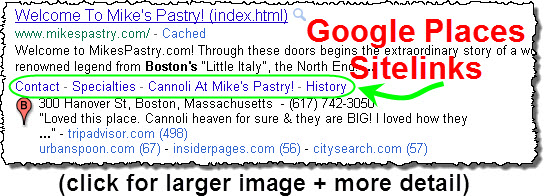What’s are “Google Places sitelinks”? They’re these:
Little links in the search result for your website–links that lead to several specific pages in your site.
Sitelinks have appeared in Adwords ads and some organic search results for a long time. But only recently have they started showing up in the local search results.
More specifically, they show up in Google’s “blended” local search results–that is, when you have a bunch of local business / Google Places search results mixed up in with a standard “organic” search results–as in the picture above. In any given local market, customers will see either this “blended” layout, or they’ll see the slightly more common “7-pack” search results (which we’re a little more used to seeing in Google Places.)
If you have a website–and you absolutely must have one unless you’re a barber shop in Mayberry–you want it to rank as highly as possible in the organic search results. Duh.
To the extent that the “blended” local search results (above) appear when you type in a local search term that you want to be found for, you want your site to be as visible as possible in those “blended” local search results, too. You get maximum local visibility by doing two things:
1. Ranking as highly as possible in Google Places, AND
2. Hogging as much territory on the blended search-results page as you can. This is why you need to try to get Google Places sitelinks. They take up an extra line of space on the page, and they draw attention the themselves.
You can use the resources on this site to accomplish #1. But how about #2? How can you get the sitelinks to show up under YOUR site?
Google won’t say, exactly. According to Google, your site has to be “useful” to the visitor, and it has to be easy for Google’s bots to find your pages. It’s an algorithm that determines whether you get sitelinks: as with a box of chocolates and everything Google-related, you never know what you’re gonna get.
Fine…but how do you get the sitelinks?
I suggest you follow 5 main steps, which are in rough order of importance:
1. Feature helpful, informative, all-original content that’s highly relevant to the services you offer, for which you’re trying to get visible in Google Places. Content is still King. Sure, there are plenty of princes, jesters, and eunuchs who also occupy the court to a lesser extent. But none wields the influence over the great land of Google that King Content still wields. It’s also how you’ll get other sites to link to yours spontaneously, and good relevant content helps your Google Places ranking big-time. If you’re not sure how to create good, relevant content that your customers will actually find useful, I suggest you take a look at CopyBlogger. It’s a superb source of ideas.
2. Use a simple page structure. Don’t have your “Services” page, your “Contact Us” page, and your articles pages nested in a bunch of other pages. The structure should not be “www.yoursite.com/locations/2011/page-you-want-a-sitelink-for.html”. It should be more like www.yoursite.com/page-you-want-a-sitelink-for.html”.
3. Make sure your page names are concise. Google looks at this. If you want your “Specialties” page to get a sitelink, make sure it’s called “specialties.php” or something. Ideally, make the menu button match the page name. If your page name is too long, Google won’t give you a sitelink, based on what I’ve seen.
4. Get Google Webmaster Tools set up on your site (if it isn’t already) and then use it to submit a “Google Sitemap.” This will help Google crawl your site. Plus, it’s free.
5. Keep grinding away at your link-building campaign. Getting good content on other sites, with links back to yours, is still a great way to show Google how “useful” your site is. This probably isn’t news to you; I’m just saying don’t forget to keep up with it.
IF the “blended” local search results show up in Google Places in your local market (as opposed to the “7-pack”), these 5 steps should not only help get your business visible there in the first place, but should also help you snag some sitelinks, more on-page territory, and more local customers than your competitors have.

[…] (By the way, here’s a post I did on how you can get sitelinks from Google.) […]